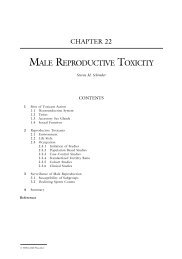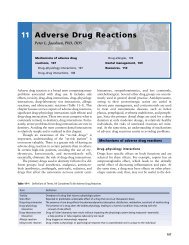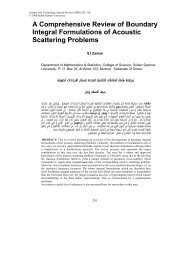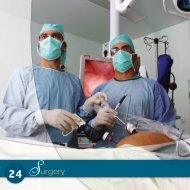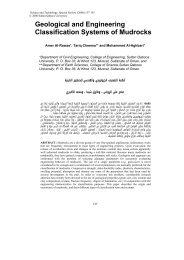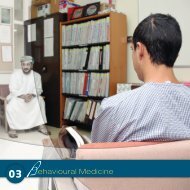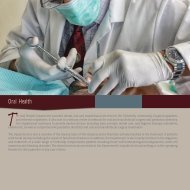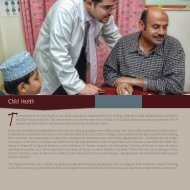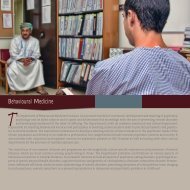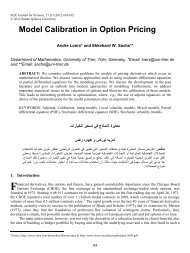81. Neonatal Hypotonia
81. Neonatal Hypotonia
81. Neonatal Hypotonia
- No tags were found...
You also want an ePaper? Increase the reach of your titles
YUMPU automatically turns print PDFs into web optimized ePapers that Google loves.
<strong>Neonatal</strong> <strong>Hypotonia</strong> / 529or loss of hair on the occiput) may provide corroborativeevidence of longstanding hypotonia.Passive ManipulationProvided there is no limitation of joint movement (eg,arthrogryposis), flexor tone in the limbs may be evaluatedby observation of the power of recoil after rapid release ofan extended limb. Tone in the trunk and neck is assessedby observation of head and neck control during tractionmaneuvers, horizontal (prone) suspension, and verticalsuspension. The traction response, present by 33 weeks ofgestation, is the most sensitive measure. Thus, at term,when the infant is pulled by the arms from a supine to asitting position, the head should remain aligned with thebody (“absent head lag”) and the infant should respond tothe traction by flexion at the elbows, knees, and ankles. By40 weeks of gestation, when the infant is supported in aprone position with the examiner’s hands under the infant(ie, “horizontal suspension”), extensor tone in the neckmuscles should permit lifting of the head to maintain theneck and trunk in alignment for brief periods. During verticalsuspension when the infant is lifted up by the axillaewith the examiner’s hands around the thorax, the shouldermuscles should be strong enough to permit suspensionof the infant vertically with the head held erect and flexionat the hips, knees, and ankles. In hypotonic infants, thehead typically falls forward and the legs dangle and theinfant has a tendency to “slip through” the hands of theexaminer. Both spasticity (ie, velocity-dependent increasein resistance during passive limb movement) and rigidity(ie, constant increased resistance to passive manipulationthroughout the range of movement) may be tested in newbornsin a fashion similar to that used in older individuals.Examination of resistance of the hips to passive abductionis an important test for spasticity in the lowerextremities (eg, spastic diplegia), a common pattern ofabnormal tone in infants born prematurely.Some investigators have described specific maneuversfor the passive manipulation of limbs in the neonate (eg,approximation of heel to ear, hand to opposite ear “scarfsign,” and measurement of popliteal angle) in an attemptto quantify the maturation of muscle tone.Tendon Reflexes and Plantar ResponseThe formal examination of tendon reflexes in the newbornmay be of limited value because the range of normalityis difficult to define. Thus, there may be markedvariability in the briskness of reflexes from one occasion toanother in the same infant. Reflexes tend to be less activein premature infants. Reflexes in the lower limbs, especiallythe patellar reflexes, typically appear more brisk andare easier to elicit than those in the upper extremities. Theknee jerks may be accompanied by crossed adductorresponses, which, unless pronounced, should not necessarilybe considered abnormal until after 6 to 8 months ofage. Similarly, up to five to ten beats of ankle clonus maybe considered normal, especially in infants who are crying,hungry, or jittery and in whom there are no other signs ofupper motor neuron dysfunction.Classically, the plantar response in the newborn hasbeen considered to be extensor. However, there is considerablevariation in this response depending on the techniqueused because of several competing reflexes that areinvolved. For example, a mild stimulus (eg, dragging thethumbnail along the lateral aspect of the sole of the foot)results in flexion of the toes in more than 90% of infants,whereas a more painful stimulus generally results in anextensor response. Thus, the plantar response should beconsidered to be of limited value for determining the presenceof an upper motor neuron lesion in the newborn.Muscle Power and MovementThe quantity, quality, and symmetry of both spontaneousand elicited movements are of major importance in the evaluationof central nervous system (CNS) function in pretermand term infants. In premature infants, movements of thetrunk and limbs often have a slow, asymmetric, twisting andstretching quality that may resemble athetoid movements.In addition, there may be rapid, jerky, wide-amplitude limbmovements that resemble myoclonus. By 32 weeks of gestation,movements are predominantly flexor, often occurringsymmetrically. By term, infants are particularly active,with smooth, alternating limb movements of medium speedand intensity in response to gentle stimulation.Normal movement patterns in the newborn are characterizedby their overall variability. Consequently, repetitive,stereotypical movements (eg, bicycling of the legs and rowingof the arms) should raise suspicion of neurologicabnormality (eg, seizure). <strong>Hypotonia</strong> is often accompaniedby an overall decrease in spontaneous and elicited movements.Increased frequency of movements may be associatedwith cerebral irritability. Movements that are consistentlyasymmetric may be a sign of focal brain injury orbrachial plexus injury. Jitteriness, which involves markedstimulus-sensitive tremulousness of the limbs that may beinhibited by changing the limb position, may be normal, orit may occur in the context of neurologic dysfunction (eg,hypoxic-ischemic encephalopathy and drug intoxication).Sensory ExaminationCareful sensory examination is important in the contextof hypotonia and should not be limited to eliciting a with-Current Management in Child Neurology, Third Edition© 2005 Bernard L. Maria, All Rights Reserved <strong>Neonatal</strong> <strong>Hypotonia</strong>BC Decker Inc Pages 528–534





